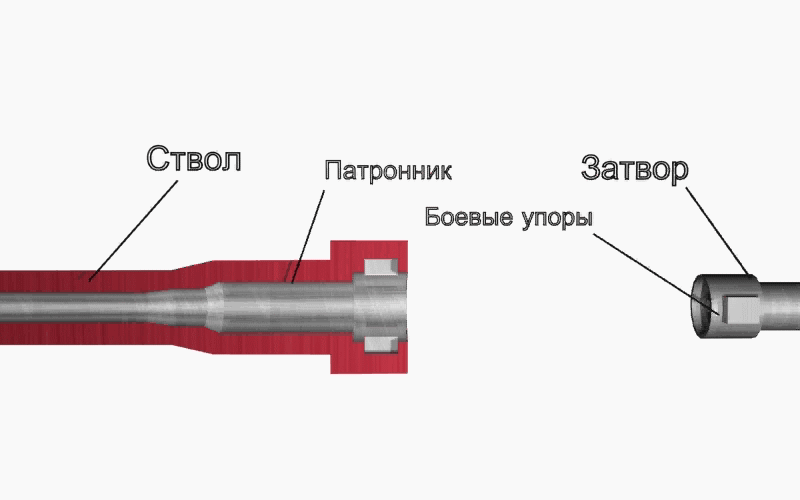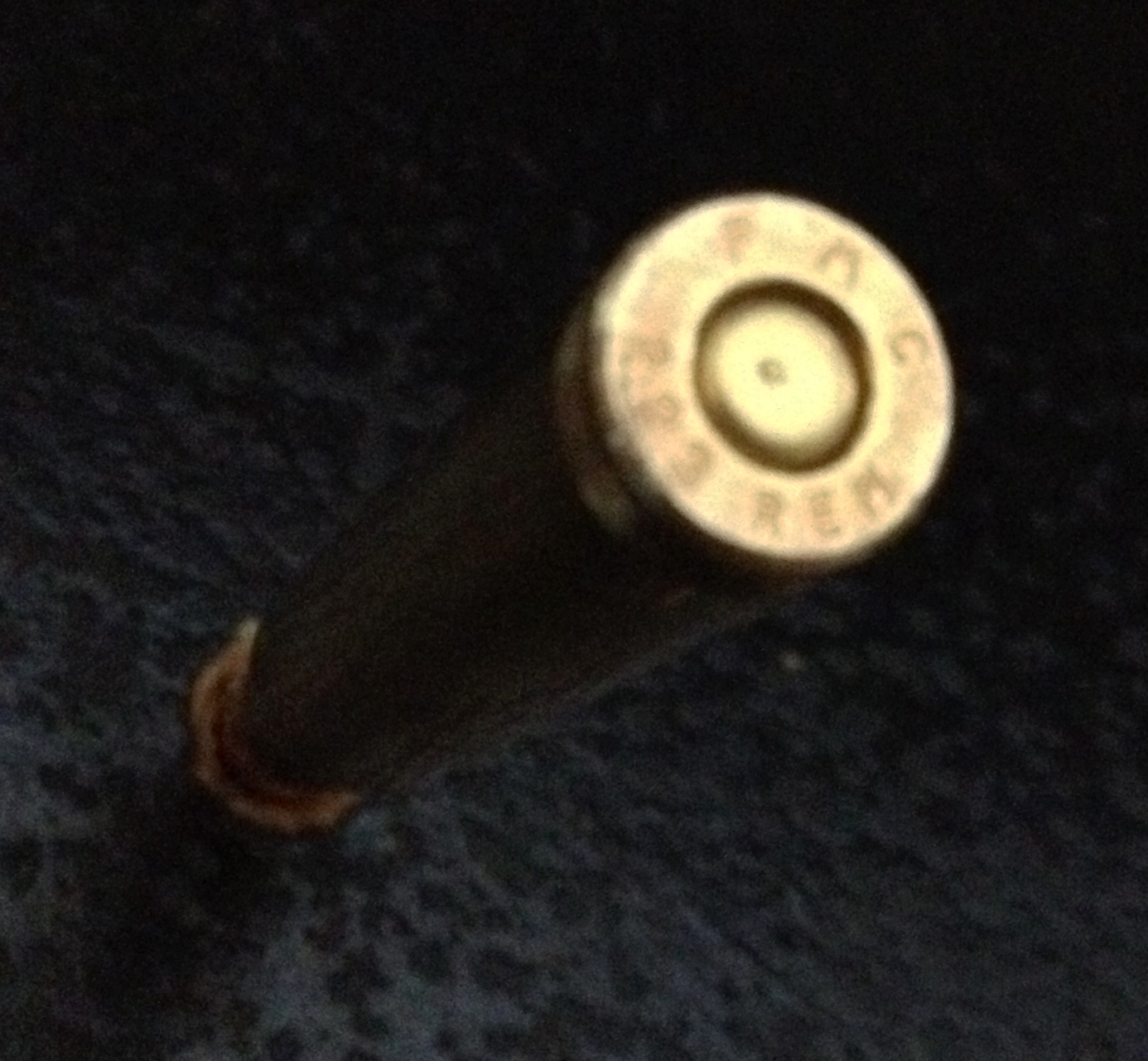Slamfire on:
[Wikipedia]
[Google]
[Amazon]
 A slamfire is a discharge of a
A slamfire is a discharge of a
 Firing pins intended to be activated by a trigger are either spring-loaded or free-floating. Both may move forward during the loading process when the face of the bolt hits the head of the chamber. Although the amount of forward movement is not intended to detonate the primer, slamfires occur when conditions do not match design assumptions.
Cartridges which may be entirely satisfactory in manually loaded firearms may be considered defective if they do not meet the design specifications of self-loading firearms. Primer depth is very important in centerfire ammunition. Most cartridges are assembled with the exposed surface of the primer a specified distance deeper than the base of the cartridge in contact with the bolt face. Primers with insufficient depth may be detonated by the normal amount of firing pin movement as the cartridge is chambered by forward bolt movement. Primer response to impact is a function of the thickness and
Firing pins intended to be activated by a trigger are either spring-loaded or free-floating. Both may move forward during the loading process when the face of the bolt hits the head of the chamber. Although the amount of forward movement is not intended to detonate the primer, slamfires occur when conditions do not match design assumptions.
Cartridges which may be entirely satisfactory in manually loaded firearms may be considered defective if they do not meet the design specifications of self-loading firearms. Primer depth is very important in centerfire ammunition. Most cartridges are assembled with the exposed surface of the primer a specified distance deeper than the base of the cartridge in contact with the bolt face. Primers with insufficient depth may be detonated by the normal amount of firing pin movement as the cartridge is chambered by forward bolt movement. Primer response to impact is a function of the thickness and
 A slamfire is a discharge of a
A slamfire is a discharge of a firearm
A firearm is any type of gun that uses an explosive charge and is designed to be readily carried and operated by an individual. The term is legally defined further in different countries (see legal definitions).
The first firearms originate ...
occurring as soon as a cartridge is being loaded into the chamber. Some firearms are designed to slamfire, but the term also describes a malfunction of self-loading firearms. Shooters accustomed to firearms requiring trigger activation for discharge may be unprepared for a slamfire discharge.
Some military firearms are designed to fire from an open bolt
A firearm is said to fire from an open bolt or open breech if, when ready to fire, the bolt and working parts are held to the rear of the receiver, with no round in the chamber. When the trigger is actuated, the bolt travels forward, feeds a car ...
condition to avoid the unintended discharge of a chambered cartridge cooking off
Cooking off (or thermally induced firing) is unfired weapon ammunition explosion, exploding prematurely due to heat in the surrounding environment. The term is used both for detonation of ammunition not loaded into a weapon, and unintended firin ...
in a gun barrel heated by firing previous cartridges. Activating the trigger of such firearms releases the spring-loaded bolt to move forward stripping a cartridge from the magazine
A magazine is a periodical literature, periodical publication, print or digital, produced on a regular schedule, that contains any of a variety of subject-oriented textual and visual content (media), content forms. Magazines are generally fin ...
into the chamber. The firing pin impacts the primer as the cartridge is chambered, and the energy released by the discharging cartridge returns the bolt into an open position while ejecting the empty case.
Unintentional slamfire
More conventional self-loading firearms begin this cycle with a cartridge already in the chamber and await activation of the trigger to allow the firing pin to impact the primer, causing discharge and loading another cartridge into the chamber. The first cartridge must be loaded from the magazine by manually pulling back and then releasing the spring-loaded bolt to chamber the cartridge; and unintentional slamfires may occur if the firing pin activates the primer as the first cartridge is being chambered. Unintentional slamfires may also occur during the normal self-loading process following an intended discharge. Control of firing pin movement is the essential difference between cartridge discharge as the bolt closes, or discharge when the trigger is pulled. Firearms designed to discharge as the bolt closes may have a fixed firing pin or a firing pin which moves forward byinertia
Inertia is the natural tendency of objects in motion to stay in motion and objects at rest to stay at rest, unless a force causes the velocity to change. It is one of the fundamental principles in classical physics, and described by Isaac Newto ...
as forward motion of the bolt ceases when the cartridge is fully chambered, while more conventional firearms are designed to prevent the firing pin from impacting the primer until the trigger is pulled. Some unintentional slamfires are caused by firing pin malfunction, while others may be attributed to defective cartridges with improperly positioned or unexpectedly sensitive primers.
Possible causes
 Firing pins intended to be activated by a trigger are either spring-loaded or free-floating. Both may move forward during the loading process when the face of the bolt hits the head of the chamber. Although the amount of forward movement is not intended to detonate the primer, slamfires occur when conditions do not match design assumptions.
Cartridges which may be entirely satisfactory in manually loaded firearms may be considered defective if they do not meet the design specifications of self-loading firearms. Primer depth is very important in centerfire ammunition. Most cartridges are assembled with the exposed surface of the primer a specified distance deeper than the base of the cartridge in contact with the bolt face. Primers with insufficient depth may be detonated by the normal amount of firing pin movement as the cartridge is chambered by forward bolt movement. Primer response to impact is a function of the thickness and
Firing pins intended to be activated by a trigger are either spring-loaded or free-floating. Both may move forward during the loading process when the face of the bolt hits the head of the chamber. Although the amount of forward movement is not intended to detonate the primer, slamfires occur when conditions do not match design assumptions.
Cartridges which may be entirely satisfactory in manually loaded firearms may be considered defective if they do not meet the design specifications of self-loading firearms. Primer depth is very important in centerfire ammunition. Most cartridges are assembled with the exposed surface of the primer a specified distance deeper than the base of the cartridge in contact with the bolt face. Primers with insufficient depth may be detonated by the normal amount of firing pin movement as the cartridge is chambered by forward bolt movement. Primer response to impact is a function of the thickness and hardness
In materials science, hardness (antonym: softness) is a measure of the resistance to plastic deformation, such as an indentation (over an area) or a scratch (linear), induced mechanically either by Pressing (metalworking), pressing or abrasion ...
of the metal cup containing the detonating explosive. Primers intended to respond to the comparatively light firing pin impact of older or smaller manually-loaded firearms may be initiated by the relatively energetic self-loading process necessary to reliably chamber cartridges. Most military ammunition makes use of hard primers unlikely to be detonated by a comparatively light inertial strike. The NATO
The North Atlantic Treaty Organization (NATO ; , OTAN), also called the North Atlantic Alliance, is an intergovernmental organization, intergovernmental Transnationalism, transnational military alliance of 32 Member states of NATO, member s ...
military alliance
A military alliance is a formal Alliance, agreement between nations that specifies mutual obligations regarding national security. In the event a nation is attacked, members of the alliance are often obligated to come to their defense regardless ...
uses NATO specific standardization agreement
In NATO, a standardization agreement (STANAG, redundant acronym, redundantly: STANAG agreement) defines processes, procedures, terms, and conditions for common military or technical procedures or equipment between the member countries of the alli ...
s (STANAGs) that define the minimal and maximal allowed primer sensitivity for small arms ammunition. For 5.56×45mm NATO ammunition STANAG 4172, among a considerable number of technical requirements, specifies the permissible primer sensitivity range for 5.56×45mm NATO ammunition.
Spring-loaded firing pins may move further forward than expected during the loading process if the restraining spring is broken or weakened by age. As rust, dirt, fouling, or inappropriately viscous lubricant
A lubricant (sometimes shortened to lube) is a substance that helps to reduce friction between surfaces in mutual contact, which ultimately reduces the heat generated when the surfaces move. It may also have the function of transmitting forces, ...
s accumulate in the firing pin channel, both free-floating and spring-loaded firing pins may be held in a forward position protruding from the bolt face. While rust prevention is important, wet lubricants can trap carbon and other pollutants from burning propellant, so avoidance of excess lubrication reduces the risk of slam fires from firing pins becoming stuck forward.
Anything adhering to the tip of a firing pin or the portion of the bolt face behind the primer may cause unexpectedly heavy primer contact during the self-loading process. The larger priming compound distribution area of rimfire ammunition increases the number of locations where dirt or fouling on the bolt face or in the rim portion of the firearm chamber may deform the cartridge rim enough to function as a firing pin during the self-loading process.
Risks
Unintended slamfires are dangerous, and recoil may cause shooters to lose control of light firearms with conditions causing sequential slamfires if a normally semi-automatic firearm "goes full-auto" unexpectedly. A single defective cartridge may cause a single slamfire, but a firing pin stuck in a forward position or a magazine loaded with defective ammunition may cause a round to fire every time the bolt closes until the magazine is empty. Shooters must keep the firearm pointed in a safe direction ("downrange") while closing the bolt and chambering a cartridge. If a slamfire does occur, the shooter must do his or her best to hold the firearm securely pointed in a safe direction until it ceases firing. This requires discipline, because untrained shooters may become surprised and instinctively drop the firearm as soon as it begins firing. Aside from the dangers of any accidental discharge, an out-of-battery ignition may occur if a round slamfires before it is completely secured in the chamber. The firearm may be damaged or destroyed by a breech explosion potentially injuring the shooter and bystanders.Intentional slamfire designs
Pipe guns use a free floatinggun barrel
A gun barrel is a crucial part of gun-type weapons such as small arms, small firearms, artillery pieces, and air guns. It is the straight shooting tube, usually made of rigid high-strength metal, through which a contained rapid expansion of high ...
with a rimmed cartridge (usually a shotgun shell) inserted in the breech, sliding within a pipe functioning as a tubular receiver with a fixed firing pin in the back. No trigger or lockwork is required, because the loaded barrel is simply inserted into the pipe and slammed backward to fire. Some use improvised detachable magazines.
See also
* Advanced primer ignition * Bump stock * Firearm malfunction * Glossary of firearms terms * Glossary of military abbreviations *List of established military terms
This is a list of established military terms which have been in use for at least 50 years. Since technology and doctrine have changed over time, not all of them are in current use, or they may have been superseded by more modern terms. However, th ...
* Recoil operation
References
{{Firearms Firearm terminology